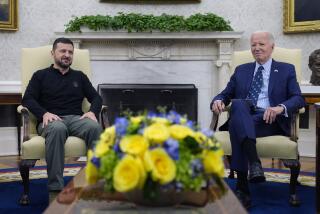Defense Firms Aren’t Ready to Give Up on the Military : Jobs: Despite talk of technology conversion, companies still seek Pentagon funds. Efforts seem to have paid off for Northrop, which could profit from the F/A-18 fighter contract.
The post-Cold War era has brought talk of peace dividends and defense conversion, but South Bay aerospace firms are still lobbying hard to keep their bread-and-butter military contracts coming.
Such efforts appear to have paid off for Northrop Corp., which makes and assembles much of the fuselage and tail section of the F/A-18 fighter at its El Segundo and Hawthorne plants.
Next month, chances are good that Congress will pass the Navy’s 1993-94 budget request of $1.5 billion for 36 additional F/A-18s, a tactical carrier fighter commonly referred to as the Hornet. Also up for approval is a $1.4-billion request for the development of the next generation of the aircraft--the “E” and “F” models.
The federal boost for the F/A-18 program could add an additional 1,000 jobs to Northrop’s South Bay work force by early next year, according to company officials. It could also ensure that a large share of Northrop workers will be employed at least through 1996.
“There seems to be two camps in the defense industry,” said Steve Jarvis, director of the state’s Office of Competitive Technology. “The company that is retrenching or sticking with what they know best, (and) the companies that are, for various reasons, making bigger investments in the commercial market.”
Although Northrop has made forays into defense conversion, such as leading the prototype design of a proposed advanced technology bus, the company has made no secret of its intention to capture a larger slice of the shrinking military budget.
“As the defense budget comes down, obviously programs become more competitive,” said Wallace C. Solberg, corporate vice president and general manager of the company’s aircraft division. “You have to tell your story more often. . . . But I don’t see anything that we can do (in defense conversion) that is going to replace the F/A-18.”
Since production began 15 years ago, Northrop has delivered nearly 1,200 center and aft fuselage sections and vertical tails to the project’s prime contractor, McDonnell Douglas Corp. in St. Louis.
Already, Northrop’s work force on the current generation of the fighter has dwindled to about 2,500 employees, from 4,700 six years ago. The company expects to deliver 52 sections of the fighter this year, compared with 141 in 1987. Some of the orders include F/A-18s supplied to the air forces of Australia, Canada, Spain and Kuwait.
The next generation F/A-18s, which would have longer range, more power and an expanded weapons system, are expected to be in production by 1996. The Navy would begin using the aircraft in 2000.
Northrop and McDonnell Douglas are not the only California companies that would benefit from continued production of the fighter. More than 950 companies in the state take part in the plane’s manufacture, including nearly 60 firms in the South Bay, according to Northrop.
Eager to keep that business, California lawmakers, including Sens. Diane Feinstein and Barbara Boxer and Rep. Jane Harman (D-Marina del Rey), are citing national security concerns to argue for continued funding of the fighter. They say the F/A-18 is needed for regional conflicts, such as the Gulf War, that continue to erupt around the world.
“There will always be a need for this type of mid-range fighter, either for regional threats or nuclear proliferation,” Harman said.
Funding for the fighter has the backing of the Clinton Administration, and it has passed key votes in the Senate and House armed services committees.
As they press for spending on the F/A-18, Harman, Feinstein and other California lawmakers are also seeking greater federal “conversion” assistance to help defense contractors tap the commercial market, particularly companies in California.
“You have to do both,” Feinstein said after speaking to about 800 workers at the plant on Wednesday. “(The United States) can and should not give up its technical superiority. What you have to do is be more discriminating. You have to recognize that you can’t have the sun and the moon and the stars in terms of new systems.”
Even if Congress approves funding for the F/A-18 program in the next budget, there is no guarantee it will continue to do so, particularly given the fiscal pressure created by the federal budget deficit.
At the same time, experts say, it is unlikely the country will forgo new weapons systems altogether, so defense companies adept at landing contracts can still do well.
“Defense has always been a hard sell to the general public,” Jarvis said. “It’s not getting any easier. But there will always be a Bosnia or a Somalia to keep in the minds of the public that you can’t go to zero.”
For defense contractors, that means survival of the fittest.
“It used to be that you worked at Northrop, McDonnell Douglas, Lockheed and all the rest of them and you would leave one and go to another,” said Grover G. Belcher, 55, of Compton, a structural mechanic on the F/A-18 program for the past 11 years. “But it’s not like that anymore because they are all in the same boat that we are in.”
Politicians and industry analysts expect more such winnowing to come.
“The defense industry will continue to be a big contribution to the California economy,” Jarvis said. “It just won’t be on the scale that it used to be. If you are the best at what you do, you can survive.”Fighting for Fighters
More than 50 South Bay companies help build the Navy’s F/A-18 Hornet strike fighter and are campaigning for continued federal funding of the plane.
PLANT FIGHTER COMPANY LOCATION COMPONENTS Northrop Hawthorne, Fuselage, twin El Segundo vertical tails, wiring, hydraulics Hughes Aircraft El Segundo Radar system AlliedSignal Aerospace Torrance Air-conditioning systems Sweeney Engineering Gardena Valves Brek Manufacturing Gardena Machine parts El-CO Machine Products Inglewood Machine parts Jackson Aerospace Gardena Machine parts
More to Read
Inside the business of entertainment
The Wide Shot brings you news, analysis and insights on everything from streaming wars to production — and what it all means for the future.
You may occasionally receive promotional content from the Los Angeles Times.










